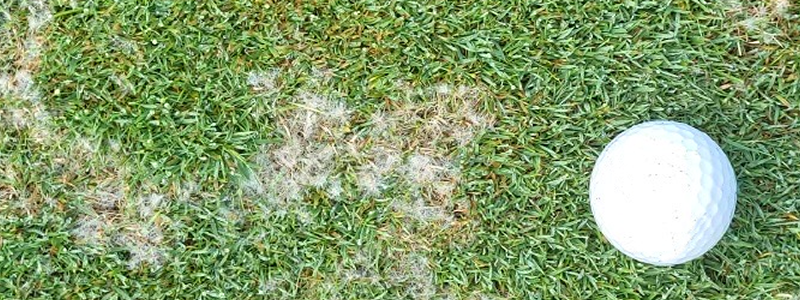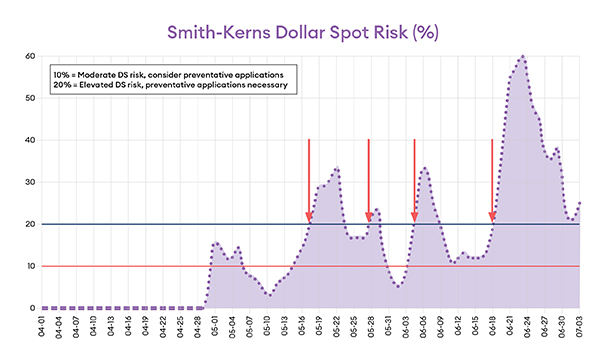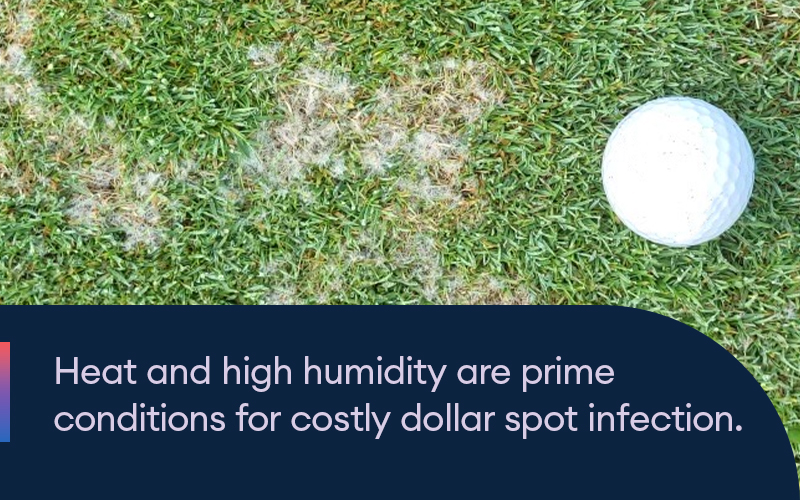Dollar Spot Management; An Integrated Approach
As temperatures and humidity increase across the country, reports of Dollar Spot incidence are on the rise. True to its name, Dollar Spot is the most expensive turf disease in North America in terms of turf damage and curative fungicide applications.
Although dollar spot can be managed curatively, supers will find they are chasing outbreaks all season long. The good news is that research is advancing our understanding of this disease, enabling us to achieve better outcomes long-term using an integrated approach. This article compiles the most recent research to assist you in effectively managing dollar spot this season and hopefully beyond.1
What you need to know: This disease thrives in temperatures between 15-30°C with high humidity (70% or greater) being the key factor in its development. It is identified by small, circular infection centers and hourglass-shaped leaf lesions, caused by the Ascomycete Clarireedia jacksonii or a closely related Clarireedia species.

Overseeding for long-term results: No grass cultivar is completely resistant to this disease, and creeping bentgrass and annual bluegrass tend to be quite vulnerable. There are bentgrass varieties that show higher resistance than others, like L-93. Implementing cultivars or varieties with dollar spot resistance through overseeding, even as a blend, is the most viable long-term strategy for managing this disease. For variety selection, see the National Turfgrass Evaluation Program (NTEP) information page https://www.ntep.org/states/ut1/ut1_btg.htm.
Fertilization rates that show promise: Research shows that increasing nitrogen fertilization rates up to 29.3 kgN/ha can significantly reduce dollar spot.1 Testing leaf tissue and maintaining nitrogen levels above 4.5% to 5% has shown improved control and significantly fewer dollar spot infections in creeping bentgrass.2 High applications of ferrous sulfate (48.8 kg/ha of FeSO4) have also been found to reduce dollar spot severity, with iron being the key factor.3 However, research has not yet identified other significant nutrients, and studies show mixed results.
Impactful cultural practices: Frequent and vigorous daily dew removal early in the morning, combined with daily mowing and morning rolling seven days a week, has been shown to reduce dollar spot by 50% to 80%, even with extended fungicide intervals.4 Additionally, the timing of irrigation is important: daily night-time irrigation is recommended despite the link between humidity and disease. Research indicates that reducing irrigation will increase drought stress because dollar spot is also associated with low soil moisture.5
The optimal fungicide schedule: There are three common types of fungicide scheduling programs – threshold, calendar and model based. Threshold schedules are reactive, involving curative applications after visible signs of dollar spot. This method is not recommended because by the time dollar spot appears, there is already a high fungal inoculum deeper in the grass, leading to continuous outbreaks and damage throughout the season. Calendar-based schedules, which typically involve applications every 14 days, are effective but can be costly. The ideal schedule uses a forecasting model, such as the Smith-Kerns model, to predict dollar spot outbreaks. This proactive approach has shown the greatest success and is more cost-effective, often extending application intervals up to 21-28 days.
Smith-Kerns for precise applications
The Smith-Kerns model provides an optimal solution. Why does it work? The load of fungi in your grass is high just before outbreak – applications timed before you see the damage when conditions are right will disable the disease in its tracks before it does the most damage. Using a logistic regression to predict disease based on a 5-day moving average of temperature and humidity, this model calculates a weekly risk index that is time tested. Applications are recommended when the model reaches or exceeds 20%. Dr. Koch’s lab in Wisconsin has a free excel file you can use to calculate this model using your local temperature and humidity: https://tdl.wisc.edu/dollar-spot-model/.
For our Stressgard® Advantage Club Members:
Envu’s TurfViewTM platform (FIG 1. below) also utilizes this predictive model to assist customers in saving extra applications when the model is below 20%.
Here's how it works: When the Smith-Kerns dollar spot risk rises above 20%, apply your initial targeted 28-day application (typically around mid-May). After this date, use the model to predict your second application, applying when the graph shows a value of 20% or higher. Continue to use the model for subsequent applications. Already started a scheduled approach? No problem, you can interrupt your schedule to use the predictive model for preventative applications anytime. Open TurfView to access your dollar-spot model, which provides precise temperature and humidity values for your location, allowing you to generate a tailored graph in real time.

Since dollar spot is a foliar disease, select spray nozzles and spray volumes that provide good coverage to maximize fungicide activity. Integrating cultural and chemical control strategies with the latest research information provides the most effective control of this fungal disease long term.
Envu fungicide program
Mirage® Stressgard® fungicide provides broad-spectrum control of important diseases with a proven active ingredient for dollar spot control, tebuconazole. It’s a great product in summer-to-fall disease prevention programs to control dollar spot and other late summer diseases.
Exteris® Stressgard® fungicide is formulated with a novel SDHI active ingredient, fluopyram, that is combined with trifloxystrobin to provide long-lasting preventative and curative control of foliar turf diseases, including dollar spot, anthracnose, brown patch and leaf spot. It provides preventative and fast curative dollar spot control on fairways from 14-28 days.
For more information about dollar spot, download the solution sheet or contact your local Territory Sales Manager for dollar spot control strategies specific to your needs.
References
- Townsend, R., Millican, M.D., Smith, D., Nangle, E., Hockemeyer, K., Soldat, D. and Koch, P.L., 2021. Dollar spot suppression on creeping bentgrass in response to repeated foliar nitrogen applications. Plant Disease, 105(2), pp.276-284.
- Davis, J.G. and Dernoeden, P.H., 2002. Dollar spot severity, tissue nitrogen, and soil microbial activity in bentgrass as influenced by nitrogen source. Crop science, 42(2), pp.480-488.
- McCall, D.S., Ervin, E.H., Shelton, C.D., Reams, N. and Askew, S.D., 2017. Influence of ferrous sulfate and its elemental components on dollar spot suppression. Crop Science, 57(2), pp.581-586.
- Delvalle, T.C., Landschoot, P.J. and Kaminski, J.E., 2011. Effects of dew removal and mowing frequency on fungicide performance for dollar spot control. Plant disease, 95(11), pp.1427-1432.
- Dykema, N.M., 2014. Impact of irrigation regime and host cultivar on dollar spot of creeping bentgrass. Michigan State University.
ALWAYS READ AND FOLLOW PESTICIDE LABEL DIRECTIONS.
Envu, the Envu logo, Mirage® Stressgard® and Exteris® Stressgard® are trademarks owned by Environmental Science U.S. LLC. or one of its affiliates.
©2024 Environmental Science U.S. LLC. All rights reserved.

